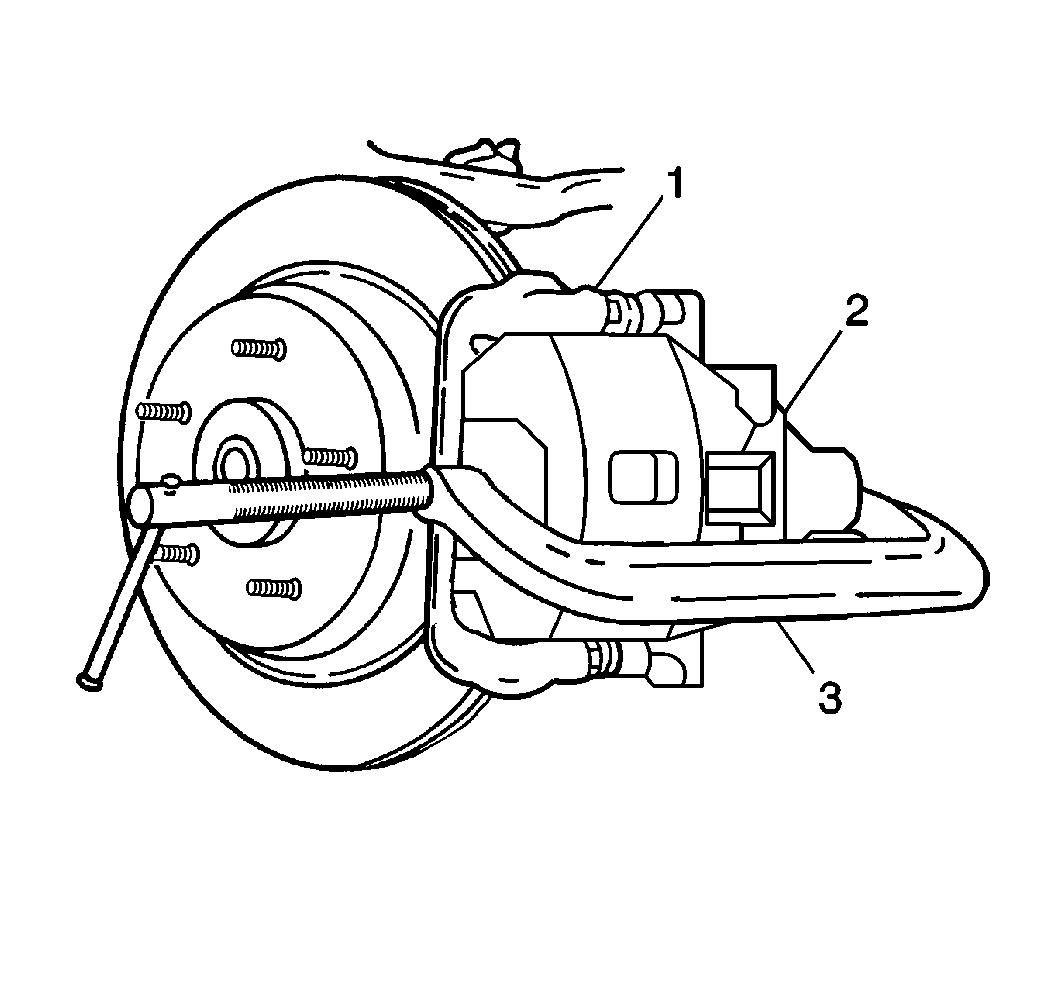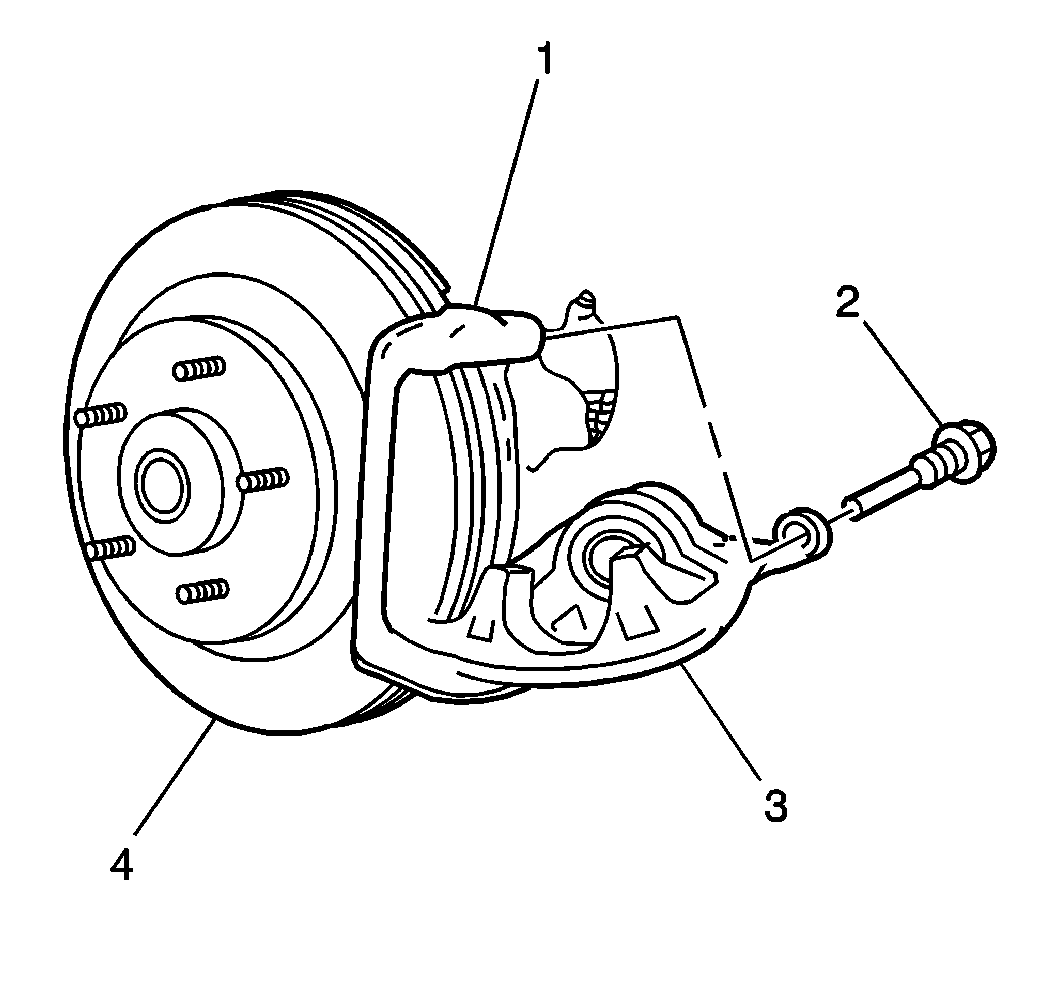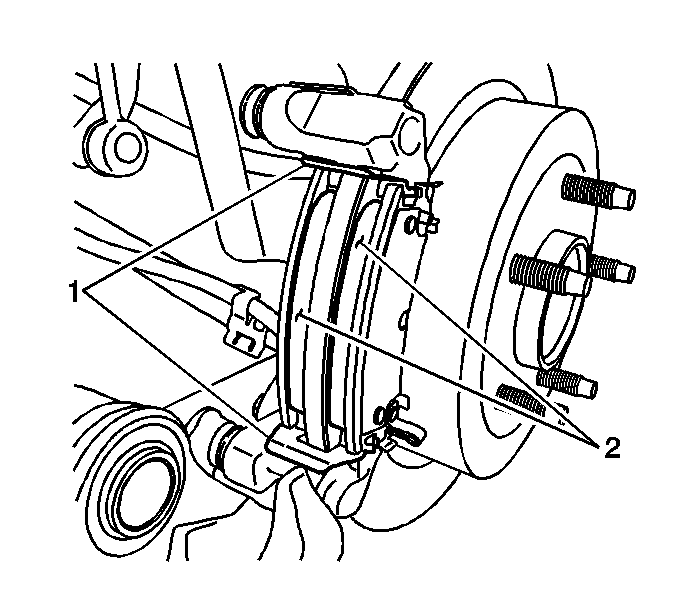Removal Procedure
Caution: Refer to Brake Dust Caution in the Preface section.
- Inspect the fluid level in the brake master cylinder reservoir.
- If the brake fluid level is midway between the maximum-full point and the minimum allowable level, then no brake fluid needs to be removed from the reservoir before proceeding. If the brake fluid level is higher than midway between the maximum-full point and the minimum allowable level, then remove brake fluid to the midway point before proceeding.
- Raise and suitably support the vehicle. Refer to Lifting and Jacking the Vehicle .
- Remove the rear tire and the wheel assembly. Refer to Tire and Wheel Removal and Installation .
- Install a hand tightened lug nut to retain the rotor to the hub.
- Compress the caliper piston enough for clearance. Use a C-clamp (3).
- Remove the upper caliper bolt (2).
- Pivot the caliper down in order to access the pads. It is not necessary to remove the caliper.
- Remove the brake pads (2) from the caliper bracket.
- Remove the 2 pad clips (1) from the caliper bracket.
- Inspect the caliper mounting hardware for the following conditions:
- Inspect the caliper dust boot for the following conditions:
- Inspect the caliper bolts for corrosion or damage. If corrosion exists, use new caliper bolts when installing the caliper.


Notice: Use care to avoid damaging pin boot when rotating caliper.
Notice: Support the brake caliper with heavy mechanic wire, or equivalent, whenever it is separated from its mount and the hydraulic flexible brake hose is still connected. Failure to support the caliper in this manner will cause the flexible brake hose to bear the weight of the caliper, which may cause damage to the brake hose and in turn may cause a brake fluid leak.

| • | Cuts |
| • | Tears |
| • | Deterioration |
| • | Replace any hardware if damage exists. Refer to Rear Disc Brake Mounting and Hardware Inspection . |
| • | Cuts |
| • | Tears |
| • | Deterioration |
| • | Replace the caliper dust boot if damage exists. Refer to Brake Caliper Inspection . |
Installation Procedure
- Bottom the piston into the caliper bore.
- Install the 2 retainers (1) to the caliper bracket.
- Install the pads (2) to the caliper bracket.
- Swing the caliper (3) upward in position around the pads.
- Lubricate the bolt and the bolt boot. Use silicone grease.
- Install the upper caliper bolt (2).
- Remove the wheel lug nut retaining the rotor to the hub.
- Install the rear tire and the wheel assembly. Refer to Tire and Wheel Removal and Installation . Align the previous marks on the wheel, hub and bearing.
- Lower the vehicle.
- With the engine OFF, gradually apply the brake pedal to approximately 2/3 of its travel distance.
- Slowly release the brake pedal.
- Wait 15 seconds, then repeat steps 10 and 11 until a firm brake pedal is obtained. This will properly seat the brake caliper pistons and brake pads.
- Fill the brake master cylinder reservoir to the proper level. Refer to Master Cylinder Reservoir Filling .
- Burnish the pads and rotors. Refer to Brake Pad and Rotor Burnishing .

Use a C-clamp before installing new brake pads in order to compress the piston. Use an old brake pad or wooden block across the face of the piston to avoid damage to the piston or the caliper boot.
Important: The wear sensor is on the outside pad. The sensor is positioned at the trailing or downward edge of the pad during forward wheel rotation.

Notice: Use care to avoid damaging pin boot when rotating caliper.
Notice: Refer to Fastener Notice in the Preface section.
Tighten
Tighten the caliper bolt to 44 N·m (32 lb ft).
